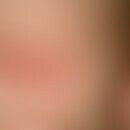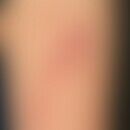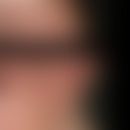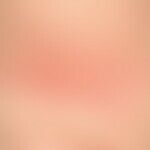Synonym(s)
DefinitionThis section has been translated automatically.
Mostly congenital, harmless, merely cosmetically disturbing, capillary malformations without any tendency to vascular proliferation, as observed in asymmetrical vascular hamartomas. There are no known syndromal associations with other organ malformations in fissural vascular hamartomas. These patches also do not represent cutaneous mosaics in the sense of postzygotic mutations.
Occurrence/EpidemiologyThis section has been translated automatically.
Fissural vascular malformations occur in up to 40-50% of newborns. Turkoglu Z et al. (2010) observed vascular fissural malformations in the forehead area over 3 generations.
You might also be interested in
EtiopathogenesisThis section has been translated automatically.
It is probably a circumscribed maturation delay of the sympathetic vascular innervation and not a vascular malformation (a cutaneous genetic mosaic is excluded), as is present, for example, in lateralized, asymmetric nevus flammeus (OMIM:163000; mutation in GNAQ/GNA11).
LocalizationThis section has been translated automatically.
Symmetrical vascular hamartomas of the skin are mainly localized in the area of the embryonic closure ridges (fissural vascular hamartomas), e.g. on the neck (stork bite), middle of the forehead or glabella (angel kiss or salmon spot), on upper eyelids and nostrils.
Clinical featuresThis section has been translated automatically.
Light red or dull red, 0.5-10.0 cm in size, bizarrely circumscribed, inhomogeneous spots.
Particularly designated are:
- the Unna-Politzer neck nevus
- and
- the salmon spot of the middle of the forehead (stork bite).
The Unna-Politzer neck nevus often does not regress - in contrast to the salmon spot of the middle of the forehead, which is usually regressible.
TherapyThis section has been translated automatically.
Therapy is not necessary for medical reasons. The skin changes are usually cosmetically little disturbing. In any case, 1/2 year should be waited because of the spontaneous tendency to regression.
In case of cosmetic therapy indication: see below. Nevus flammeus.
Progression/forecastThis section has been translated automatically.
Favorable, no progression, tendency to regress during infancy. They are therefore called ′′fading macular stains'.
No tubero-nodal transformation as in the so-called nevus flammeus lat.
LiteratureThis section has been translated automatically.
- Csoma Z et al. (2014) Birth marks and neonatal skin disorders. From angel kiss to epidermolysis bullosa]. Orv Hetil 155:500-508
Turkoglu Z et al (2010) Angel's kiss in three generations. Indian J Dermatol Venereol Leprol 76:592.
Incoming links (5)
Bohring Opitz Syndrome; GNAQ; Naevus flammeus fissurale; Nevus flammeus symmetricus; Unna stain;Outgoing links (5)
Asymmetrical nevus flammeus; GNA11 Gene; Mosaicism; Unna stain; Vascular malformations ;Disclaimer
Please ask your physician for a reliable diagnosis. This website is only meant as a reference.








